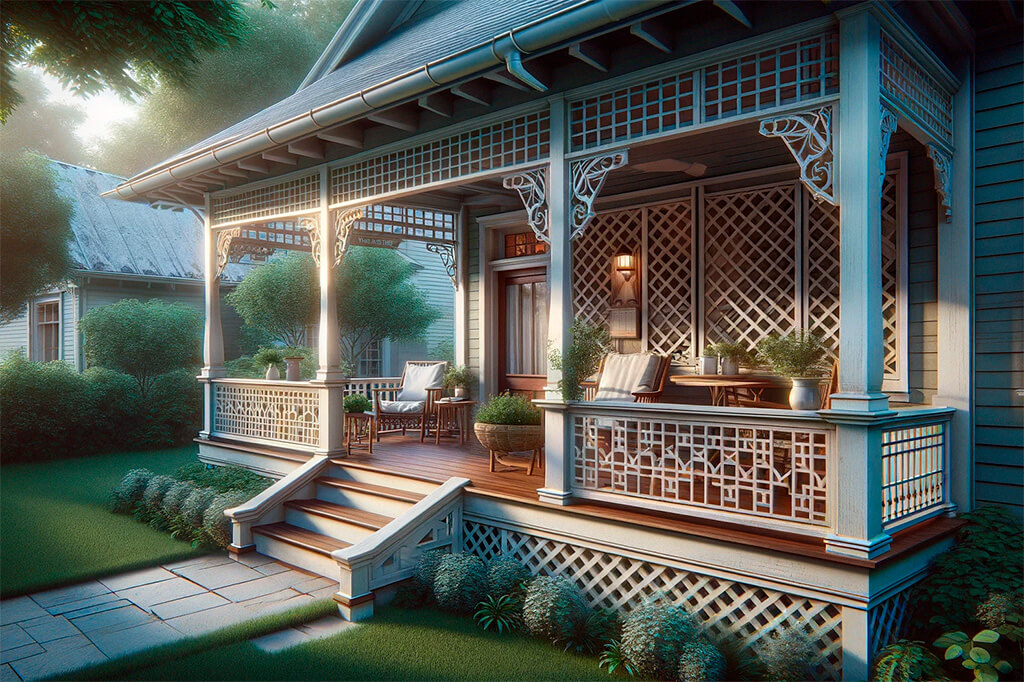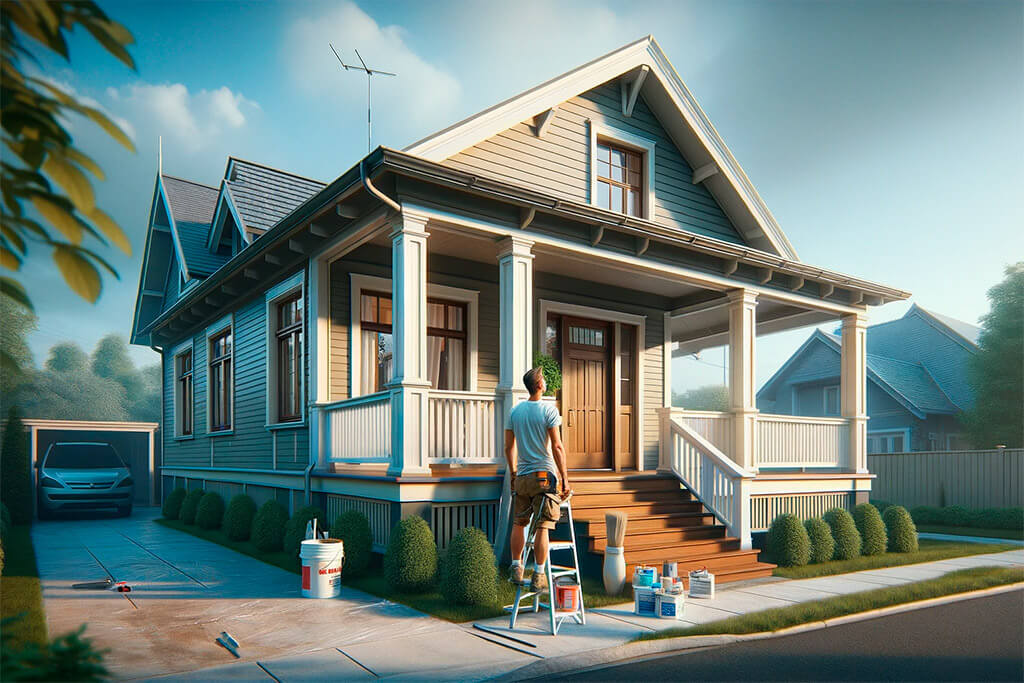When considering the addition of a screened-in porch, it’s like opening a new chapter in your home’s story. These spaces offer not just an aesthetic boost but also practical benefits that enhance your everyday living. For the DIY enthusiasts, home handymen, and construction professionals, it’s an opportunity to create a space that’s both functional and inviting.

- Expanded Living Area: It’s like adding an extra room without the cost of a full extension.
- Protection from Pests: Enjoy the outdoors without the annoyance of insects.
- Boost to Property Value: A well-constructed porch can be a selling point.
- Versatility for All Seasons: With the right design, it can be a year-round haven.
The Basics of a Screened-In Porch
Think of a screened-in porch as a hybrid space where the comfort of your living room meets the freshness of the outdoors. It’s enclosed with screens that offer protection while maintaining an outdoor feel.
- Screens: The first line of defense against insects, while allowing fresh air to circulate.
- Roofing: Provides shade and shelter, integral to the porch’s functionality.
- Framing: The backbone of your porch, which can be crafted from various materials to match your home’s style.
Understanding the Variations:
- Screened Porch: Often an extension of the house, sharing a common roof.
- Screened Patio: More akin to an outdoor room, can be an independent structure.
- Screened-In Sunroom: Enclosed with glass or screens, sometimes climate-controlled for all-season use.
Design Considerations
Planning is key to ensuring your screened-in porch meets your needs and complements your home.
- Orientation: Consider the path of the sun and prevailing winds for maximum comfort.
- View and Privacy: Position your porch to capture the best views while maintaining privacy.
- Access: Seamless transition from indoors to outdoors is crucial for functionality.
Materials Selection:
- Screens: Choose between fiberglass for its resilience or aluminum for clarity.
- Framing: Wood offers a traditional feel, while metal brings a contemporary edge.
- Roofing: Align with your home’s existing roofing, or opt for something unique like transparent panels for natural light.
Integrating with Your Home’s Style:
- Aesthetic Alignment: Ensure the porch design is in harmony with your home’s architecture.
- Color Schemes: Complementary or contrasting, the choice can dramatically alter the appearance.
- Detailing: From flooring to trim, small touches can make a big difference.

Screened Porch Ideas and Inspirations
Rustic Charm
Embracing the rustic charm in a screened porch is like bringing the serenity of a cabin into your backyard. Opt for sturdy, natural timber for framing – think cedar or pine for that authentic, rugged appearance. The flooring should be robust and welcoming, wide plank boards can create a stunning effect. Furnish with classic pieces like wooden rockers or a porch swing, and add softness with quilts or braided rugs. Incorporating elements like a stone fireplace can elevate the ambiance, blending warmth with the rustic aesthetic.
Modern Minimalism
For a modern minimalist screened porch, the mantra is clean lines and uncluttered space. Structural elements should be sleek, using materials like powder-coated aluminum for framing and composite for decking, ensuring longevity and minimal maintenance. Furniture should be simple yet functional – think streamlined benches and low-profile lounge chairs. Use a neutral color palette, and let the architecture speak for itself. Recessed LED lighting can provide a subtle glow without overpowering the minimalistic design.
Classic Elegance
Creating a classic elegant screened porch is about balancing comfort with sophistication. Architectural details such as turned posts, decorative railings, and classic beadboard ceilings can add character. Choose a palette of soft, muted colors to imbue a sense of calm and grace. Furnishings should be both comfortable and stylish, wicker or wrought iron furniture adorned with plush cushions offers a timeless look. Enhance the elegance with refined touches like an ornate ceiling fan or understated pendant lights.
Screened-in Sunroom
A screened-in sunroom is where functionality meets comfort. Consider removable screens to adapt to changing seasons. Flooring should be durable yet inviting, like ceramic tile that mimics wood or stone. Furnish with indoor comforts like cozy sofas and armchairs in weather-resistant fabrics. Incorporate elements like ceiling fans for warmer days and a small gas heater for chilly evenings. Plants and soft lighting can create a serene retreat, perfect for enjoying the beauty of the outdoors while nestled in indoor comfort.
DIY Tips and Tricks
Building a Basic Screened-In Porch
- Foundation: Ensure a solid and level foundation, which may mean pouring concrete footings or securing to an existing deck.
- Framing: Construct a robust frame using pressure-treated lumber, ensuring all joints are securely fastened and squared.
- Screening: Choose quality screens for durability, install them taut to avoid sagging. Consider removable screen panels for easy maintenance.
- Roofing: Match your home’s roofing style for a cohesive look. Properly install flashing to prevent water leakage.
Materials and Tools
- Essential materials include pressure-treated lumber, quality screens, and matching roofing materials.
- Basic tools needed: hammer, power saw, level, tape measure, drill, and safety gear like gloves and goggles.
- Always have extra fasteners and hardware on hand to avoid mid-project runs to the hardware store.
Safety and Mistakes to Avoid
- Prioritize safety: wear protective gear and follow proper tool handling procedures.
- Check local building codes to ensure compliance, especially for structural elements.
- Avoid cutting corners on materials – investing in quality pays off in the long run.
Decorating Your Screened Porch
Furniture, Lighting, and Accessories
- Choose furniture that complements the porch’s style and your comfort needs.
- Opt for weather-resistant fabrics and materials to ensure longevity.
- Lighting should balance functionality with ambiance, consider dimmable options for versatility.
Multi-Functional Space
- Designate areas for different activities: a dining area, a lounging spot, and perhaps a small gardening section.
- Select furniture that can serve multiple purposes, like ottomans that double as extra seating or storage.
- Incorporate elements like foldable or extendable tables for adaptable space usage.
Seasonal Decor
- For summer, light fabrics and vibrant colors can create a lively atmosphere.
- In autumn, transition to warm throws and earthy tones for a cozy feel.
- Winter decorations might include heavier fabrics and festive elements to embrace the holiday spirit.
Maintenance and Upkeep
In my years of renovating and building, I’ve learned that the longevity of a screened porch largely hinges on regular maintenance. Here’s a breakdown of essential upkeep tasks:
- Routine Cleaning: Dust and debris can accumulate quickly. Regular sweeping and gentle cleaning of surfaces are crucial. For wooden components, a soft brush and mild detergent work wonders to keep mold at bay.
- Screen Maintenance: Inspect your screens for damage periodically. Small tears can be easily repaired with a patch kit, but larger issues might require replacing the screen entirely.
- Wood Preservation: Wooden porches need occasional resealing or repainting. This not only keeps them looking fresh but also protects against rot and insect damage.
- Hardware Check: Loose fittings can lead to bigger problems. Periodically tighten any loose screws and lubricate hinges to keep everything moving smoothly.
- Winterization: In colder climates, heavy snowfall can strain your porch’s structure. Keep it clear of snow and consider protective covers for furniture to extend their life.
FAQ Section
Costs vary significantly. A basic DIY project might start around a few thousand dollars, but for a fully customized porch, it can easily go upwards of $20,000. Key factors include size, materials, and design complexity.
The timeframe varies. A simple project could be completed over a weekend, while more elaborate designs might take several weeks. Custom features and finishes will add to the timeline.
Yes, it can. A well-designed porch adds both functional space and aesthetic appeal, making it a desirable feature for potential buyers.
Fiberglass is cost-effective and easy to work with, while aluminum offers greater durability and clearer views. There are also specialized screens like those that are pet-resistant or minimize solar heat gain.
Insulation is key for colder months – consider insulating the floor and ceiling. Adding glass or acrylic panels over the screens can provide extra protection. For heating, options range from built-in fireplaces to portable heaters.
